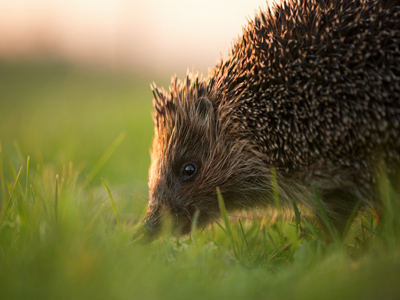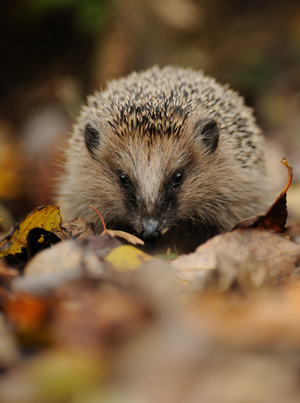Hedgehog History

Hedgehogs are one of the most familiar animals here in Britain. The spiky little creatures are a favourite with children, and we all like to see them visiting our gardens on a dark night. But all is not well with our prickly pals, and their spikes (a great defence against natural predators) offer no protection from the ravages of mankind.
For 15 million years, hedgehogs have lived happily on a diet of invertebrates, carrion, roots and berries. They hibernate through the cold, harsh winters and have few natural enemies, save the badger. But, in recent times, hedgehogs have become threatened – not by a new predator or a change in the weather. No – hedgehogs are under threat due to our own selfish actions.
Where Did Hedgehogs Originate?
Hedgehogs are probably a lot older than you think. Their closest relative is the shrew, but they parted company long, long ago. The oldest known ancestor of modern-day hedgehogs lived during the Palaeocene period, immediately after the death of the dinosaurs. They were the same size as modern hedgehogs and had a similar diet.
The true hedgehog appeared on the scene around 15 million years ago, when our ancestors had not yet separated from orangutans or gorillas. Today there are 17 different species of hedgehog living in Europe, Africa and Asia. The kind we are most familiar with is erinaceus europaeus, the European hedgehog.
There have been other kinds of hedgehog, sadly no longer with us. Perhaps the most interesting was deinogalerix, the “terrible hedgehog". As their name suggests, they were larger than modern hedgehogs and grew to around 60 cm in length – that’s about four times the size of today’s hedgehogs. Unfortunately, the last deinogalerix died around 5.3 million years ago.
Where Do Hedgehogs Live Now?
As we’ve learned, hedgehogs are native to three continents: Europe, Africa and Asia. But they have also made their way (or rather, humans have taken them) to New Zealand. When the Brits emigrated to the islands back in the 1800s, they took hedgehogs with them to remind them of home. This was a mistake – as an invasive species, hedgehogs there have become a threat to New Zealand’s native species. Ever the opportunists, hedgehogs help themselves to the eggs of ground-nesting birds. But don’t blame the hedgehog – if any species is at fault, it’s us, not them!
You can also find hedgehogs all around the world being kept as pets. Now, they may look adorable (they certainly do!) but hedgehogs do not make good pets. Putting aside the obvious threat to native wildlife if the pets escape, hedgehogs are solitary creatures and would not take kindly to a cuddle! They are also extremely active animals during their waking hours (they are nocturnal) so would definitely not like being confined to a cage.
Hedgehogs In Folklore
As a (formerly) common species in Britain, it’s not surprising that they have made their way into our folklore, as well as our hearts. Here are just a few of the things we used to believe about hedgehogs:
Hedgehogs roll on fruit to impale it on their spikes and carry it home – hedgehogs do eat fruit, but they don’t take it to their burrows, and they don’t (intentionally!) impale it on their spikes.
Hedgehogs steal milk from cows by sucking on their udders – this myth was so commonly believed in Elizabethan England that a reward was offered for any dead hedgehog.
Hedgehogs can predict the weather and seal up their burrows when a storm is due – not true, although hedgehogs are less likely to venture out in bad weather.
Hedgehogs are witches in disguise – this ridiculous belief led to the deaths of countless hedgehogs when the church offered bounties for their lives.
How Many Hedgehogs Are There In The UK?

In the 1950s there were something like 36.5 million hedgehogs living in Britain. Sadly, today there are far fewer. A recent study found that there are now approximately 1.5 million of them left in the wild. That’s a staggering decrease of 96% over the last 60 years.
So, what is to blame for this devastating decline? You might think it is the fault of cars, after all, 150,000 hedgehogs are killed on our roads each year. But this is not the biggest threat to hedgehogs – it seems that modern farming is the main culprit.
Hedgehogs rely on two things in particular to survive. They need plenty of invertebrates in order to feed, but they also need (as their name suggests) hedgerows which provide them with shelter, corridors to move along and protection from predators.
Modern farming has led to a decline in hedgerows, and in meadows (a good source of invertebrate food). With their habitat and their food source both depleting, hedgehogs are in trouble. This has led to their colonisation of towns, where they carve a living as scavengers, and in our gardens. But they face danger even there.
You see, many gardeners use slug pellets to kill what they see as pests. The trouble is, hedgehogs will eat slugs – even ones that have been poisoned. That means that they become poisoned themselves, meaning that they might be too weak to survive the winter, or be unable to reproduce.
Help Us Save The Hedgehog
Metaldehyde, a chemical used in slug pellets, was banned by the British Government in 2018, because of its danger to wildlife. That ban was overturned by the High Court in July 2019 – not because the chemical is safe, but because of “how the decision-making process was conducted”.
Since then, despite the Government being fully aware that metaldehyde is harmful to wildlife, no further action has been taken. This incensed us here at Education Quizzes. Why is nothing being done to address the issue caused by, of all things, an administrative error?
Unusually for us, we were so angry that we started a petition to ban the sale and use of metaldehyde as a pesticide. Will you help us to save the hedgehog by signing? It’s so easy to do – just follow this link.
If you love hedgehogs and want to find out more about them and our campaign, you might like to read these pages:



